During the off-season, almost all owners of country houses and summer cottages have the same problem: how to heat their home efficiently and inexpensively.

Heater for giving wall type
There are many options for heating a summer house: from a simple wood-burning stove to a modern gas boiler. One of the most popular types of heating can rightly be called electric type heaters. They are distinguished by stylish appearance, compactness, safety and ease of use.
For many areas in our country, these devices are an excellent alternative for home heating, especially in areas where gasification has not yet been carried out. How to choose the right wall-mounted electric heater for a summer residence and install it with your own hands - we will tell in this article.
Content
Advantages and disadvantages of wall heaters
It will be fair to immediately notice that a wall-mounted electric heater has much more advantages than disadvantages. Even skeptics are forced to admit that using them is a pleasure.
Another thing is that not all dachas are located in areas where civilization has reached, or there are interruptions in electricity, from which the use of such devices becomes impossible.
If the cottage is located in a well-maintained area, then the purchase of a wall-mounted electric heater will certainly please its owners with many advantages. This is especially true of dachas, where the owners make pilgrimages only for weekends and holidays. Wiring batteries throughout the house is long and expensive, and not everyone wants to build a stove.
Electric wall heaters, on the other hand, look stylish and allow you to place them even in small rooms. They are easy to install, so if necessary, you can buy the required number of heaters to increase heat transfer in the house.
Such devices can be of different shapes and designs. Innovative technologies allow them to be made light and compact. Placement on the wall in the corner saves a lot of space, while guaranteeing safety in case of accidental contact with the case.
Whatever technology the heater is made of, each of them works from a conventional electrical outlet. This allows you to organize efficient autonomous heating in the house even in the absence of the owners.
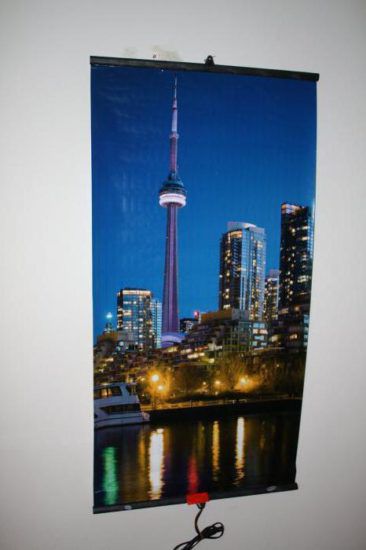
Thin and light wall-mounted heater in the form of a picture
In addition, they are extremely secure.Unlike underfloor heating devices of any type, they will not tip over, which is especially true in homes with children and pets.
Compared to gas appliances and boilers, they also guarantee 100% fire protection. There is simply nothing to explode in them, and accidental short circuit is excluded, since all devices are equipped with an automatic overheating relay.
Many people who plan to purchase such a heater are interested in the issue of cost-effectiveness, because at the current utility rates, one does not want to acquire such a large expense item. We will try to find the most economical option!
A wall-mounted heater of the electric type is very economical, since the energy expended here is converted into heat, as a result of which a high efficiency is achieved - at least 90%.
But this fact is more relative, because electrical energy is still one of the most expensive, so it would not be right to call such a device a budget option.
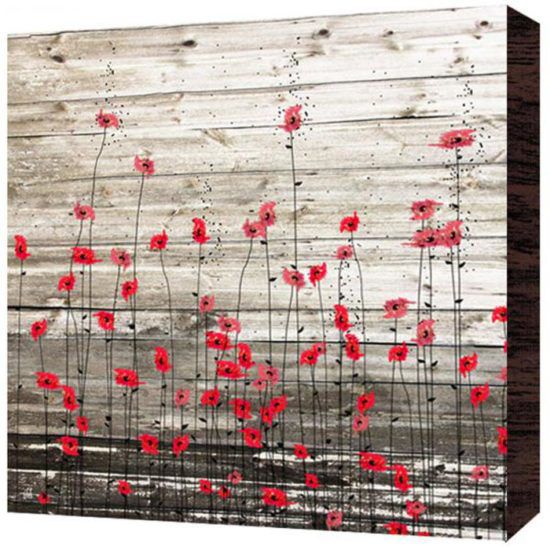
Stylish wall heater
If, in order to install a gas boiler, the owner will need to go through many instances to obtain permission, then everything is simple here. You decide how many and where to install such devices.
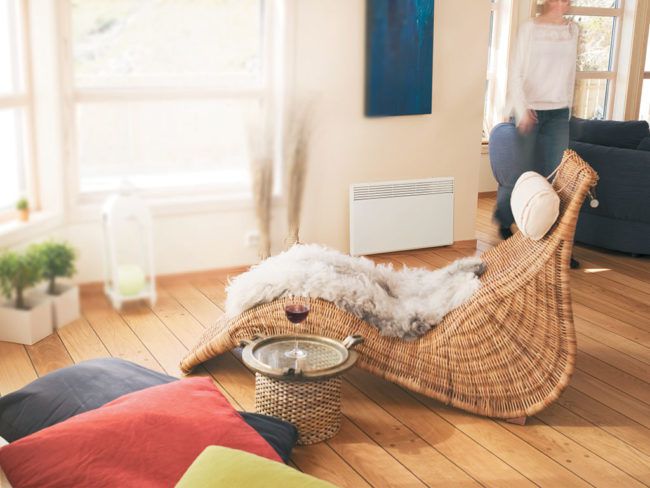
Stylish convector will effectively heat a small cottage
So, briefly about the advantages:
- stylish and compact appearance;
- the ability to work in homes where gasification has not been carried out;
- operational safety;
- do not burn oxygen;
- maintaining an optimal microclimate in the house;
- possibility of use as an auxiliary heat source;
- ease of installation;
- versatility of use (the device can be placed in any room);
- reliable fastening;
- large power range;
- high efficiency;
- automatic temperature control.
But speaking about the advantages of electric heaters, it would be unfair to mention some of the disadvantages of this type of heating for the home:
- High price.
- Heaters must be grounded when connected to avoid electric shock.
- High energy consumption.
To understand how the device works and how such a high efficiency is achieved, you should consider the main classification of wall heaters.
Types of wall heaters that can be installed in the country
Despite the fact that electric wall heaters appeared on the market only a few years ago, the modern market today offers several types of such devices that differ not only in the principle of operation, but also in their technical characteristics.
The source of operation of any type of such heaters is a socket, but depending on the material and content, the principle of such a design will be different.
Oil heaters
Such a radiator is a structure made of a one-piece hermetic steel case, inside which there is mineral oil and a heating tube (cone). When electricity is applied, the oil begins to gradually heat up and transfer heat to the metal surface.
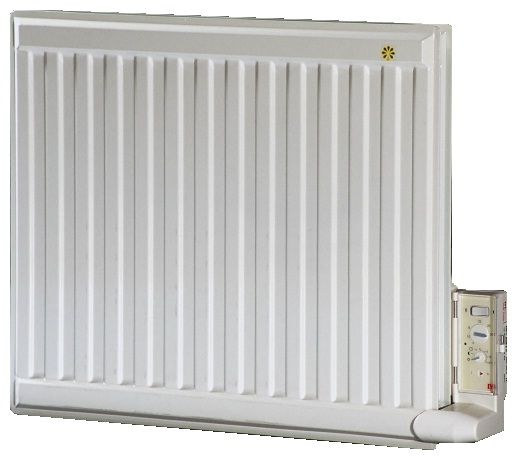
Electric oil heater
Here the principle of conventional heat transfer operates, as a result of which heat from the steel case passes into the room.
Today, this version of wall-mounted radiators is very popular, as they are distinguished by reliability, durability, lack of noise and affordable price.
Unlike water batteries, an oil cooler does not dry out the air, which ensures a comfortable microclimate in the house. During the operation of such a heater, the critical temperature is not reached and the steel panel can be safely touched by hand, excluding burns.
Among the shortcomings, their large weight should be noted, as a result of which it can not always be carried on any wall. Sometimes you need to do additional fastening.
By its design, a wall-mounted oil heater does not differ from a floor-standing counterpart, the difference is only in the mounting.
Advantages of an oil wall heater:
- affordable price;
- wide power range;
- reliability and durability of use.
Flaws:
- low power (0.5 - 1.6 kW);
- not the most economical;
- big weight;
- prolonged heating of the panel.
Convection heaters
Convectors have a simple structure:
- Steel body with holes at the top and bottom for air circulation.
- Main heating element.
- Automatic thermostat with temperature sensor.
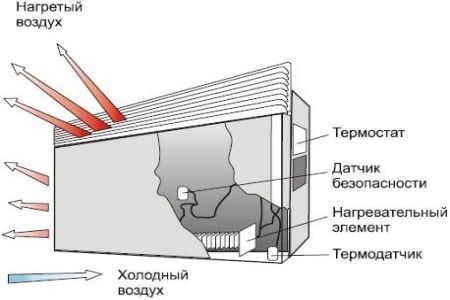
The principle of operation of the convector
Depending on the manufacturer, price and model, some convection wall heaters can be equipped with additional options: an air humidifier, a timer, an ionizer, various automatic programs (for example, “anti-freeze”), etc.
Management is carried out mechanically or using a remote control (more expensive models).
The main principle of operation of this type of heater is air convection. Cold air enters from the bottom through openings in the housing and passes through the heating element, exiting through the top louvers.
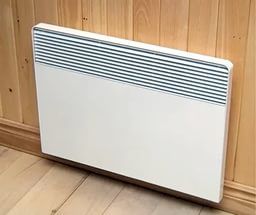
Convector
The heating element can be of various shapes: monolithic plates, pipes, needles, etc.
Today on sale you can mainly find radiators with monolithic and tubular heating elements.
Such devices have an attractive appearance and look stylish in the living room, bedroom, kitchen. But it is better to refuse to install such a heater in the bathroom, since the incoming moisture can affect the technical characteristics of the device.
Given that air is constantly circulating through the heating element, the oxygen in the room is burned out very quickly. The state of health may deteriorate sharply, dry eyes, headache may appear. This must be taken into account during operation and monitor the level of humidity.
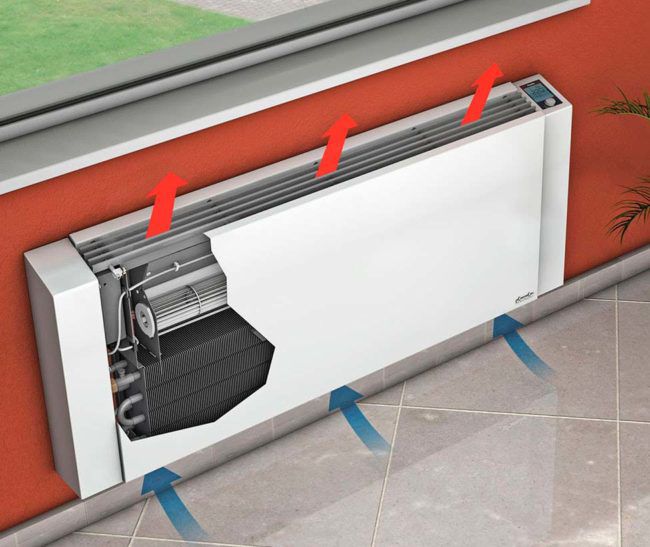
Wall convector
In addition, air circulation raises dust in the air, which falls on the heating element, which may cause a characteristic unpleasant odor.
Advantages:
- noiselessness of work;
- high efficiency;
- economical consumption of electricity;
- rapid heating of the room;
- wide power range 1.8-2.5 kW.
Flaws:
- high noise threshold;
- there may be an unpleasant smell in the room;
- the device strongly “burns out” the oxygen in the room.
Infrared heaters
This type of wall heater differs significantly in its principle of operation from previous devices. Infrared devices spend incoming electricity on heating objects, not air.
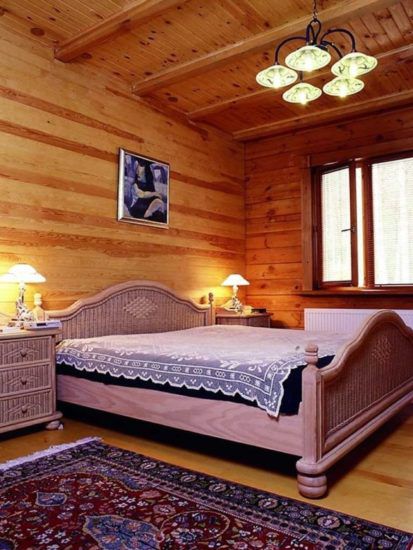
IR heater
If in the classic versions of electrical appliances heat moves away from the walls, warming up the room, then a completely different principle of operation is implemented here, which entails both advantages and disadvantages.
The room is heated by an infrared wall heater due to the propagation of electromagnetic waves that are in a given range: between the red border of the visible light spectrum. Separately, it should be said about the fire safety of the device.
The area of microwave radio emission (from 1000 to 2000 microns), and the wavelength is 0.74 microns. This principle of work is "peeped" by nature itself. In the same way, our planet extracts heat from solar energy flows, which is necessary for all living things.

IR heater in the form of a picture
The design of the IR device is as follows:
- reflector;
- heater;
- emitter;
- frame;
- insulator.
For efficient operation of the device, the thickness of the reflector foil must be at least 130 microns. Too thin foil will significantly reduce performance and reduce the life of the device.
The function of retaining heat in this type of device is performed by an insulator. Manufacturers use various materials for it, but most often you can find an insulator made of basalt on sale.
Unlike standard appliances with heating elements, which can heat several rooms at once (principle of free air circulation), IR heaters must be installed in each room.
Such heaters, unlike convection-type devices, do not dry out the oxygen in the house, allowing you to maintain an optimal microclimate in the house. If you need to warm up quickly or you need a summer cottage heater as an additional source of heat, then an IR device will be an excellent solution.

Glass ceramic IR panel
The body of an infrared heater can be made of ceramic or metal, which significantly determines the difference in their price. Glass-ceramic infrared heaters look very stylish and can even be used as room decoration.
Now many manufacturers offer such heaters in the form of film pictures.
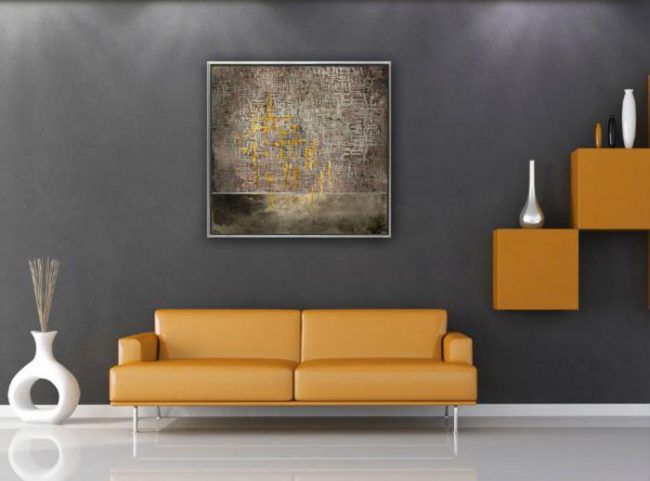
Wall IR
With proper operation, the average service life of such a device is at least 20 years, which in principle justifies their high price.
Advantages:
- compact dimensions;
- stylish appearance;
- prevents the formation of mold in the house;
- comfortable microclimate in the house;
- does not respond to voltage "jumps";
- high efficiency (almost 99%);
- safety of use;
- the possibility of installing a thermostat;
- saving electricity.
Despite a number of advantages of this type of heaters, there are several disadvantages.
Flaws:
- Models with low power provide uneven heating of the room in all its corners. When leaving the "heat" zone, a decrease in temperature is sharply felt.
- Impact on the human body. And although many studies have been conducted indicating the safety of infrared radiation, there are cases of individual intolerance to electromagnetic waves: with prolonged exposure to infrared radiation, a person begins to feel burning and dryness in the eyes, which can lead to disease of the cornea of the eye.
- The IR heater creates a powerful load on the power grid, therefore, when installing such a device at home, you must first change the old wiring and install automatic regulators.
- High cost of equipment.
Ceramic heaters
Ceramic wall heaters compare favorably with their "brothers" in appearance. In appearance, they can be mistaken for split systems. Lightweight, stylish and compact, they fit perfectly into any home decor.
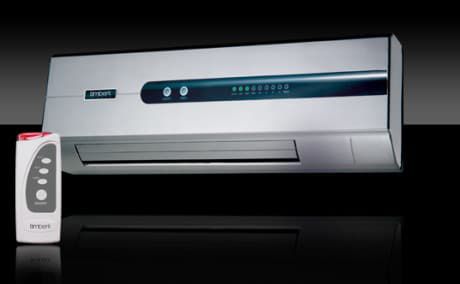
Ceramic heater
There is a heating element inside the ceramic body. And the fan that distributes warm air currents works according to the forced convection method.
Unlike an oil cooler, a ceramic heater has 4 times less power, while at the same time providing an efficiency of up to 90%.
Air access to the heating element is carried out through small holes located on the housing panel. Due to this, after turning on the device, the room warms up quickly.
The panel, made of natural stone, creates not only an optimal microclimate in the room, but also gradually releases heat, like a stone. This contributes to uniform heating of the room. In the room where such a device hangs, there will be no “cold” corners.
With proper operation, such a wall-mounted radiator can last at least 30 years, which fully justifies its high price.
The advantages of this type of heaters include:
- stylish appearance;
- durability of operation;
- energy saving up to 30%;
- environmentally friendly material;
- does not dry the air;
- high efficiency.
The disadvantages of a ceramic heater include, perhaps, only its high price and high noise threshold.
Quartz heaters.
In the world of heating appliances, quartz heaters are the newcomers. A heating element is located inside a monolithic slab made of quartz sand.As you know, quartz sand retains heat very well, which ensures quick and uniform heating of the entire room.
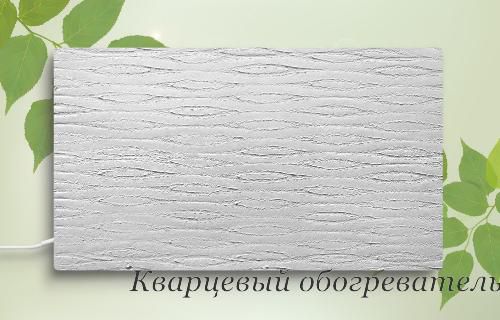
Wall mounted quartz heater
In addition, this type of heater is characterized by a low rate of temperature loss, which makes it possible to heat the house very economically even in severe frost.
Models with a power of 400-450 W will be enough to provide a comfortable temperature in a room up to 18 square meters. m.
As in the case of ceramic devices, a significant disadvantage of quartz heaters is their high price and heavy weight, which does not allow mounting the device on all ceilings.
Advantages:
- high efficiency;
- stylish appearance;
- long service life (up to 30 years);
- high heat capacity.
Flaws:
- high price of equipment;
- great weight.
To increase the efficiency of a quartz heater, it is best to install it in a set with a thermostat that monitors the on and off of the device. The thermostat is purchased separately and allows you to set the required maximum temperature in the room.
This will save you from unnecessary trouble - you will not need to monitor the climate in the house and constantly turn off the device.
In addition, the thermostat will help you easily solve the problem of dampness in the country in the autumn, winter and spring seasons during the absence of the owners: you can simply set a minimum value of 7-10 degrees, upon reaching which the device will automatically turn off until the temperature drops to a critical value. This mode will require much less electricity, but it will be more than enough to protect the house from the appearance of fungus and mold.And upon arrival, the room can be easily heated to the desired temperature even in winter.
Video. How to choose a real quartz heater
Choosing the most economical wall-mounted electric heater for summer cottages
If you decide to choose a wall-mounted electric heater for a summer residence, then you should not always be guided only by the name of the manufacturer and the price.
Of course, there are many individual preferences when choosing. Not everyone, for example, likes in infrared heaters that, apart from a person, it heats all objects (floors, decor, furniture). And some people will be uncomfortable sitting in the zone of influence of a convection device that “drives” air around the room.
There are many criteria that determine the choice of a good radiator.
- The power of the device. This criterion determines the area of \u200b\u200bthe room. Each passport must indicate what area this model can heat.
- weight and safety. This largely depends on the operation and installation of the device. Do not hang a ceramic or oil heater on a plasterboard wall. Or it is necessary to provide a very reliable fastening.
- Noise level. The convection heater creates increased noise. In the living room, this will not be felt that way, but in the bedroom, not everyone will be pleased to be in the coverage area of this device.
You should also consider additional options for heaters:
- Timer function. A handy feature for those who come to the country only on weekends. You can easily set the start time and the house will be warm by your arrival.

thermostat
- Restart. This is a factory reset option. Convenient thing.
- Remote control.
DIY installation
To install a wall heater, you will need the following set of tools and materials:
- Heater + set of spare parts for it.
- Temperature controller.
- Screwdriver.
- Construction tape measure and pencil.
- Electric drill.
- Screwdriver.
- Decide on the location of the heater. Consider the location of windows, doors, the proximity of the outlet. If you are not sure where exactly the electrical wiring runs in the wall and are afraid to get right into it, use a special detector to determine the wiring, fittings, pipes.
- Make a mark on the wall with a tape measure where the mount will be and measure with a pencil. The line between the two points should be perfectly flat, so use a building level to be sure.
- Drill the required holes with an electric drill.

Drill holes for fasteners
- In the holes formed, it is necessary to mount the brackets that come with the device. We use a screwdriver and self-tapping screws for this.
- Lay the heater on the table and remove the plug through which the wires are led out.
- Screw the fasteners to the heater according to the instructions.

Attach bracket to heater
- Carefully hang the heater on the bracket.

Bracket mount
- Now fix the heater to the wall.

Hang the heater on the wall
- Connect a three-core cable with a cross section that corresponds to the electrical load in the house (recommended PVA 3 * 1.5).
- Thermostat connection. To do this, determine the location of its placement. It is best to hang it at a level of 1.5 meters from the floor.

Installing a thermostat
You must understand that the thermostat is the middle link between the circuit breaker and the heater.
Attention! The thermostat must not be in direct sunlight or drafts.
- Bring two wires zero and phase to the thermostat from the circuit breaker.
- Open the connection socket in the thermostat and connect it to the heating device.
- Connect to the electrical network.
During the first “start-up” of the electric heater, an unpleasant smell may appear in the room, but this is a temporary phenomenon, and after 15-20 minutes the smell should disappear.
In conclusion, it should be noted that a wall-mounted electric heater for a summer residence is an excellent solution in every sense. It is easy to install, inexpensive and at the same time allows you to maintain a comfortable microclimate in the house all the time.
Video. How to hang an infrared heater on the wall
Video. Connecting a mechanical thermostat

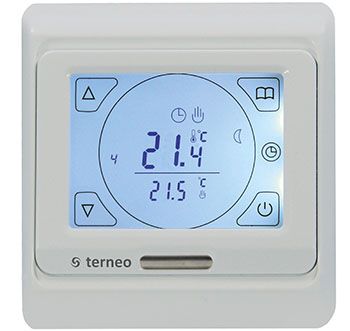


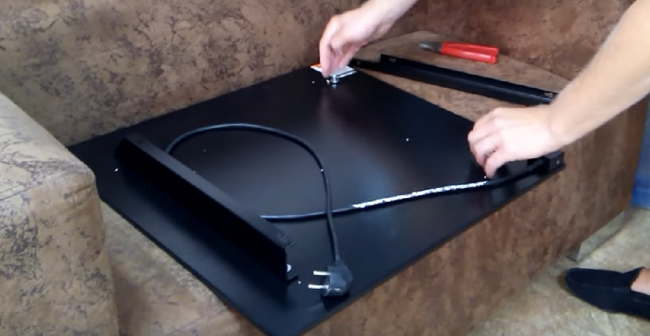


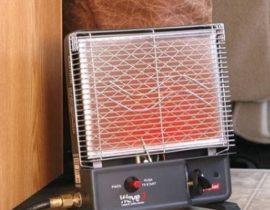
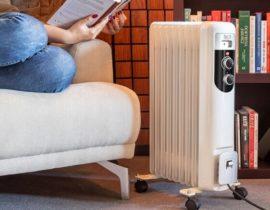
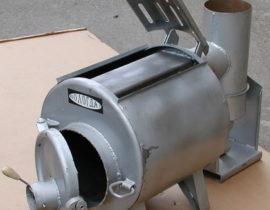

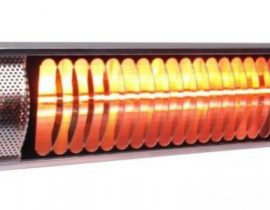

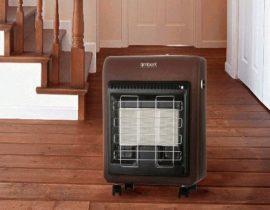

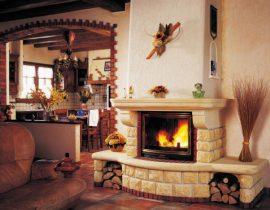



I just bought a convector heater, it can stand on legs or can be hung on the wall, the downside is that it accelerates in temperature for a long time, then only pluses, it is quiet, there is a timer.
A fan heater can be used to heat up the room more quickly, but is not entirely suitable for long stays.